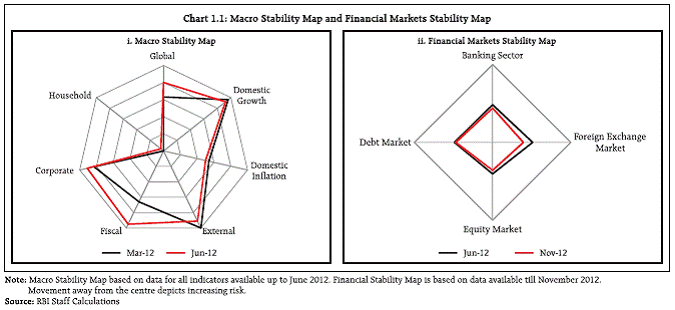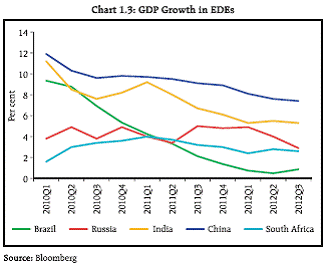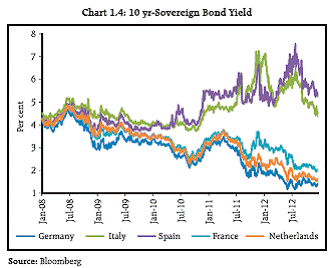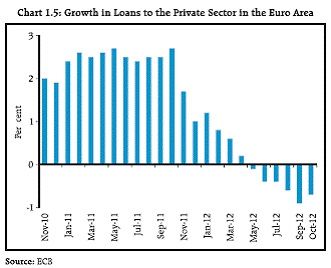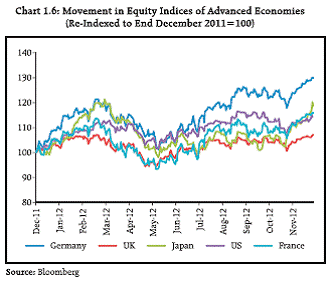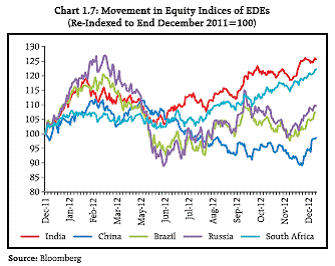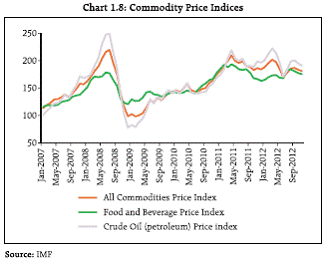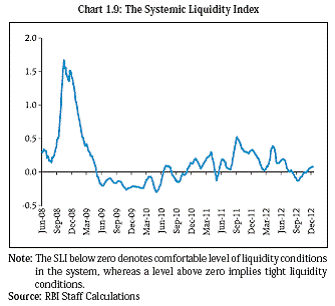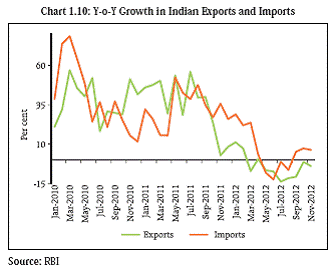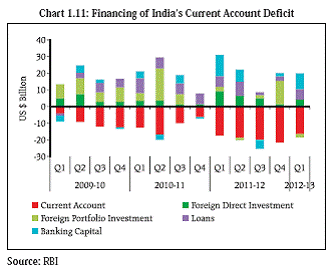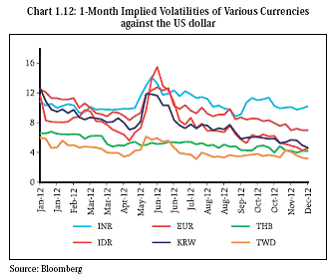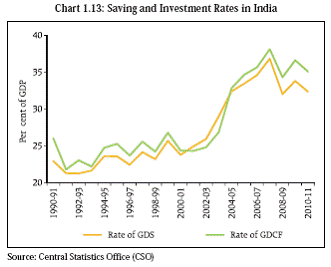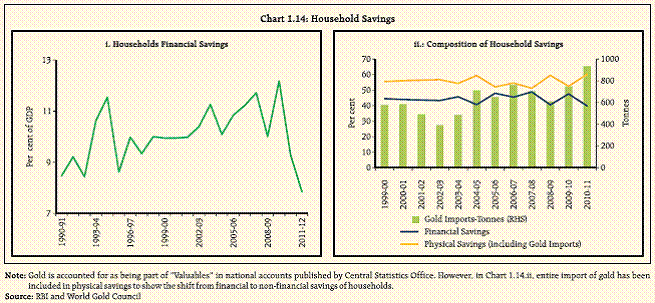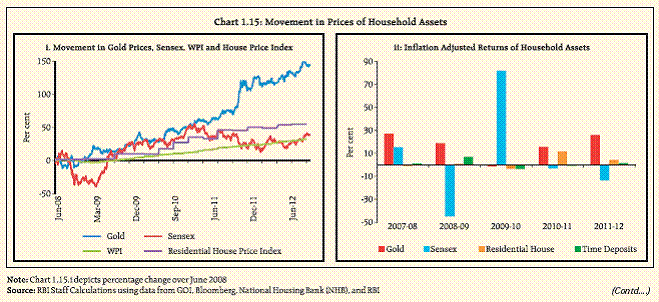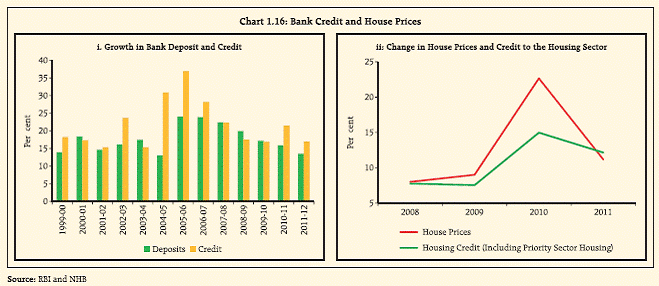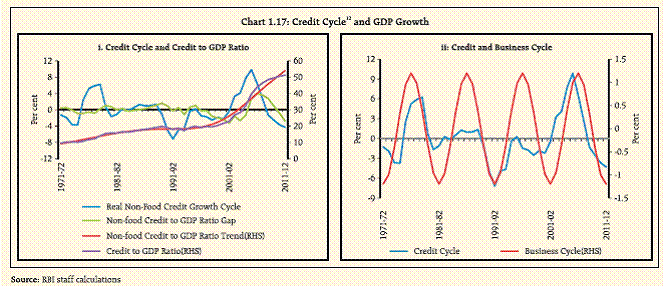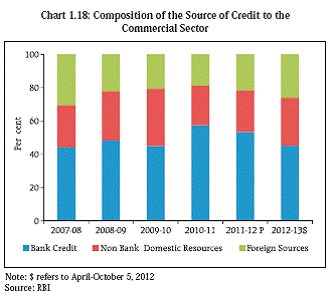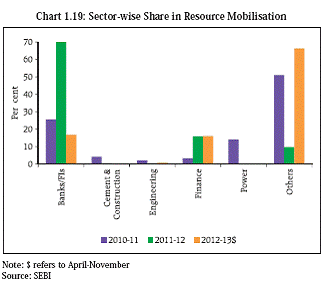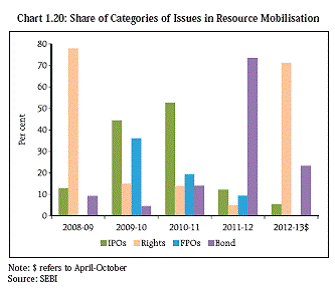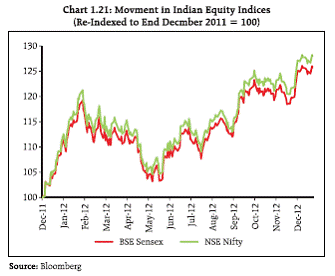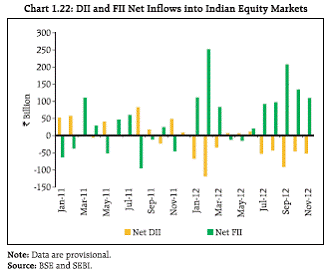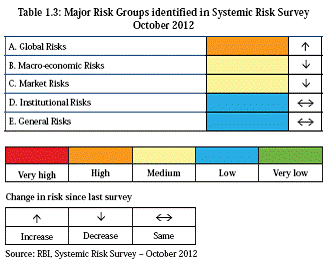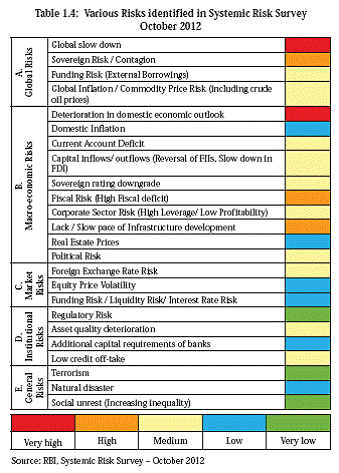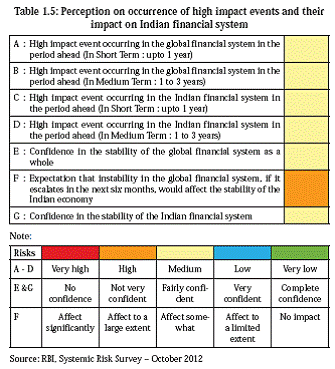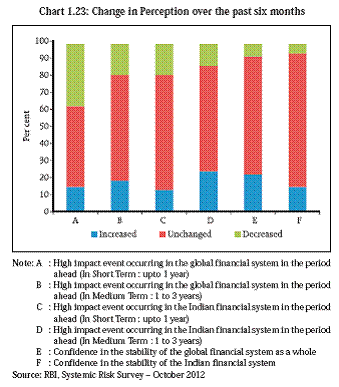 IST,
IST,
Chapter I : Macrofinancial Risks - An Assessment
Globally, growth risks seem to have risen and could offset the positive effects of enhanced liquidity. Although, liquidity infusions by major central banks have contributed to some stability in global financial markets these do not seem to be a substitute for structural solutions. Further, fiscal stress and sovereign debt problems continue to be major risks to market stability and with commodity prices still at elevated levels, risks of liquidity-driven price increases also remain significant. A major risk to the outlook stems from political economy considerations which could impede, delay or erode resolute policy actions and the consequence could be deepened financial stress and heightened risk aversion. Amidst this global slowdown and uncertainty, the Indian economy remains sluggish, held down by slowing investment, weakening consumption and declining exports. The loss of growth momentum which started in 2011-12, extended in the current year with growth remaining below the trend, however, infl ation continued to remain above the Reserve Bank’s comfort zone. On the external front, the current account deficit (CAD) remains above the comfort level and the Indian rupee witnessed depreciation pressure. Another worrying development has been the reduction in the share of financial assets in household savings as households’ preference for physical assets and valuables like gold seem to be rising, which is also adding to the pressure on the CAD. Thus, lower growth, elevated inflation, high fiscal and current account deficits remain potential risks to financial stability. Global perceptions of India’s ability to tide over the current economic weakening could hinge on its ability to effectively follow the roadmap for fiscal consolidation. This would vacate financial space for India’s private sector which is competing with the government to attract a greater share of the falling household savings. There are also early signs of corporate leverage rising among the several industrial groups with large exposure to infrastructure sectors like power. Further, many companies have large foreign currency denominated overseas borrowings with unhedged exposures at a time when volatility in exchange rates remains elevated. These pose signifi cant risks to the stability of the corporate sector. However, financial market conditions improved marginally in the period under assessment. 1.1 The overall macroeconomic risk to the Indian financial system seems to have increased since the publication of the previous Financial Stability Report (FSR) in June 2012. The global, fiscal and corporate sector risks have registered visible increases. The risks emanating from the household sector - which in the Indian context is a stabilising force – have increased marginally. The risks from domestic growth, inflation and external sector also remained elevated (Chart 1.1.i). Stability of the financial markets which was measured based on four segments of the market, namely, foreign exchange market, equity market, debt market and banking sector funding, show marginal softening of risks in all the segments compared to the previous FSR (Chart 1.1.ii).
Global Growth 1.2 Economic growth remained sluggish around the world. The global economy grew slower during 2012 (upto September 2012) than previously anticipated (Chart 1.2 and Chart 1.3). The Euro area slipped into a technical recession in Q3 2012 with Spain, Italy and Portugal experiencing protracted recession. Slower than expected economic growth in the US has led to continuation of unconventional policy measures by the Federal Reserve. Failure to resolve the issues on debt ceiling and fiscal cliff could hamper economic decisions by corporates and households which in turn could slow growth further. Growth in Japan was estimated to be (-) 3.5 per cent, on an annualized basis, in Q3 2012. Growth in the Emerging and Developing Economies (EDEs) during Q2 2012 was also lower than in the previous quarters. Although inflation pressures appear to be moderating, elevated food and commodity prices remain contingent risks to economies facing domestic supply constraints.
Euro Area Sovereign Debt Crisis 1.3 Global financial markets have been supported by announcements about European banking and fiscal integration. Investor confidence, however, remains susceptible to bouts of stress as there does not appear to be a definitive strategy to resolve the Eurozone crisis. Financial markets face risks from further deterioration of world growth prospects. While some measures have been taken to strengthen banks and sovereigns, the threat of negative feedback loops between sovereigns and banks remains a worry. European investors and banks in general are reducing exposures of foreign assets (within Europe) on fears of a country’s exit from the euro or of large banking failures. 1.4 International regulations, particularly in the area of central counterparty arrangements in various market segments, and Basel-III liquidity requirements have increased the demand for high quality collateral. The previous FSRs have discussed the trend towards greater collateralisation of transactions among banks and those with customers. Prolonged periods of economic slowdown in the advanced economies are likely to put further pressure on their already strained fiscal positions. The perception of safety of some of the European sovereigns has been dented and this reduces the available pool of high quality risk free government securities for use as collateral. This development thus could have negative consequences for the smooth functioning of financial markets. 1.5 Yields on 10 year sovereign bonds have fallen to record lows for core Euro Area countries and increased in the peripheral countries (Chart 1.4). This has resulted in marked increase in spreads of stressed sovereign bonds over German Bunds. The yields have fallen after the series of measures announced by the European Central Bank (ECB) in the recent past.
1.6 The International Monetary Fund (IMF) estimates that assets of 58 large European banks have fallen by about US $ 600 billion during Q3 2011 - Q2 2012. This has had implications for credit growth in the Euro Area with the peripheral nations being most affected. Although stabilising measures by ECB have slowed the de-leveraging process, credit to the private sector still remains weak as a large part of the ECB liquidity is being parked in the overnight deposit facility even though the interest rate on those deposits is zero (Chart 1.5).
International Financial Markets 1.7 Unconventional policy measures undertaken in some advanced economies have supported global equity markets during the year. After a period of subdued sentiments, optimism returned to global equity markets after the ECB President announced that the ECB was ready to use all possible means to save the Euro and the announcement of Outright Monetary Transactions (Chart 1.6 and Chart 1.7). However, fiscal cliff concerns have weighed on the bourses and the escalation of violence in the Gaza strip has also dampened sentiment.
1.8 Bond yields for some developed economies have remained subdued due to safe haven flows and are close to historical lows. Investors across the world have increased their holding of government paper. Besides, flight to safety has also increased concentration risk in sovereign paper. Prolonged Accommodative Policies-Downside Risks 1.9 Advanced economy central banks have adopted accommodative monetary policies in response to the Global Financial Crisis and the Euro Area Sovereign Debt Crisis. This has been seen as necessary to halt the deflationary spiral and to stimulate growth in these economies and consequently promote growth globally. Some of these policies have been unconventional as the lower bound of interest rates had been reached at the early stages of the crisis. Balance sheet size of central banks around the world has expanded stoking fears of high inflation in the future. In addition, concerns over the prolonged use of unconventional policies have emerged especially in emerging economies. 1.10 Low yields for an extended time period tend to drive investors towards riskier assets in search of higher yields. Excess liquidity created by these policies has also fuelled volatile capital flows into emerging market economies. Such flows tend to be driven more by short term factors accentuating the risk-on-risk-off trends in financial markets. Low rates also reduce the opportunity cost of capital and hence the incentive of financial firms to monitor borrowers’ financial health and ability to pay back debt. 1.11 Prolonged accommodative policies create a large demand for high quality financial assets. The pool of assets that central banks can hold is large but not infinite. Market for these securities could become illiquid if central banks hold a major portion of these securities and trading among private players falls leading to an increase in liquidity premiums1. In such a scenario, the very purpose of the accommodative policy is called to question. The increased demand could also create mis-pricing of the assets. Besides, lower bond yields could reduce fiscal prudence on part of the sovereigns allowing them to borrow more at lower rates. 1.12 Profitability of central banks could also be affected due to mark-to-market losses when interest rates rise. This could undermine the credibility of the central bank and affect financial stability. The exit strategy will have to be carefully calibrated by central banks and their credibility will be impacted severely if mistiming or wrong strategies stoke inflation expectations or raise rates too quickly. Commodity Prices 1.13 Commodity prices, as measured by the movement in the IMF’s Primary Commodity Price Indices, have remained range- bound, after peaking in March 2012. The food price index trended sharply upwards during July-August 2012 and has edged down since September 2012. The softening in Q4 of 2012 was in view of a slowdown in euro area, Japan and emerging economies like Brazil, China and India. If this trend persists, inflationary pressures arising from commodity prices could be lower. However, quantitative easing being pursued by advanced economies poses some upside risks to global commodity prices (Chart 1.8).
Domestic Growth 1.14 A number of domestic and external factors have caused a significant deceleration in economic growth in India during the last few quarters. GDP growth remained low at 5.3 per cent during Q2 2012. On the domestic front, structural impediments such as fall in domestic savings, persistently high inflation, regulatory and environmental issues resulting in a fall in investment demand and moderation in consumption spending have contributed to the fall in growth. All these factors seem to have brought down the potential growth rate to about 7 per cent. 1.15 Rise in industrial activity in October 2012 is attributed largely to base effect and festival demand. However, the significant rise in capital goods and the moderate increase in order book volumes are indications of a modest firming up of activity in Q3 of 2012-13. The Services Purchasing Managers Index (PMI) indicates a positive sentiment while the increase in rabi sowing coverage suggests improving prospects for agricultural growth. Even though inflation has softened in the recent period, the risks persist. On the external front, a weakening global economy has exacerbated the domestic slowdown. Systemic Liquidity Index 1.16 There was a significant easing of the liquidity deficit in the banking system in Q2 of 2012-13, and the liquidity deficit mostly remained within the Reserve Bank’s comfort zone of one per cent of Net Demand and Time Liabilities (NDTL) during this period. However, the liquidity conditions have tightened in Q3 of 2012-13 so far primarily on account of persistence of high government balances and the widening wedge between deposit and credit growth. The Reserve Bank’s open market operation (purchase of government securities) added primary liquidity and contained the liquidity deficit. The Systemic Liquidity Index (SLI) which is based on a multiple indicator approach and aims to capture the overall funding scenario in the financial system viz., the banking, non-banking financial, the corporate sectors and liquidity in foreign exchange market shows that the liquidity conditions have tightened marginally in Q3 of 2012-13 (Chart 1.9). Long and short term treasury yields remained largely range bound.
Fiscal Consolidation 1.17 The central government’s gross fiscal deficit (GFD) up to October 2012 constituted about 72 per cent of the budgeted amount for the whole year as against 74 per cent during the corresponding period of previous year. However, there is likely to be some shortfall in revenue collections (tax and non-tax) during the current year due to slowdown in economic growth. At the same time, there is a possibility of some overshooting of the non-planned budgeted expenditure, especially due to additional allocation for various subsidies (fuel, food and fertilizer). The central government has already brought out first supplementary demands for grants involving net cash outgo of about `310 billion, a major part of which (`285 billion) is for petroleum subsidies. A revised fiscal deficit of 5.3 per cent was announced by the Finance Minister for the year. That can be achieved only through pruning down of expenditure and greater effort in revenue mobilization. External Sector Vulnerabilities 1.18 Slowdown in global growth has reduced demand for Indian exports. On the other hand, imports have tended to slow to a lesser extent as the major portion is relatively inelastic (oil imports; Chart 1.10). This could exacerbate the current account deficit. In the face of general risk aversion, financing the CAD has become a challenge (Chart 1.11). The benefit of a depreciating currency has been muted due to weak external demand which could worsen on materialisation of US fiscal cliff. 1.19 The level of foreign exchange reserves impacts the financial stability through the confidence channel. Sharp deterioration in level of reserves could adversely impact the sentiment of the overseas investors. Further, given the fact that India is a current account deficit country, with adverse developments in international financial markets the domestic foreign exchange markets can be severely impacted if the macroeconomic fundamentals are not very strong.
1.20 Adequacy of reserves has emerged as an important parameter in gauging the ability of a country to absorb external shocks. With the changing profile of capital flows, the traditional approach of assessing reserve adequacy in terms of import cover has been broadened to include a number of parameters which take into account the size, composition and risk profiles of various types of capital flows as well as the types of external shocks to which the economy is vulnerable. Although the CAD fell to 3.9 per cent of GDP in Q1 2012-13 from 4.5 per cent during Q4 2011-12, it is still high. External sector sustainability indicators have deteriorated in the recent past (Table 1.1). The indicators relating to the foreign exchange reserves point to a declining position. The absolute level of the reserves is, however, considered to be reasonable. 1.21 Against the backdrop of volatile flows, several measures have been taken to augment capital flows into India. A new investor class, Qualified Foreign Investors (QFIs), to include non-resident individuals has been permitted to invest in Indian equities, corporate bonds and mutual funds. The relaxations in debt inflows have been made to include a larger set of eligible sectors with the focus on attracting long term sources, particularly, real money investors. Permitted limits under ECBs have been enhanced and rationalised within prudential limits particularly for corporates having natural hedges to repay the ECBs from out of their foreign exchange earnings. 1.22 A series of economic reforms announced recently by the central government appears to have had a positive impact and boosted sentiments. Moody’s has confirmed a stable outlook for India. However, other rating agencies like Fitch have warned that India’s rating could be lowered if fiscal situation does not improve.
Un-hedged Exposure of Corporates 1.23 Excessive volatility in the exchange rate makes it difficult for economic agents to make optimal intertemporal decisions. The economic agents, therefore, need to properly understand and measure the nature of currency risk embedded in their business and use appropriate derivative instruments to hedge their currency risks. Reserve Bank, over the years has expanded the menu of derivative instruments, both OTC as well as exchange traded ones which has provided greater flexibility to the market participants in managing their currency risk2. 1.24 Unhedged foreign exchange exposure of corporates is a source of risk to them as well as to the financing banks and the financial system. Large unhedged forex exposures have resulted in accounts becoming Non-performing Assets (NPAs) in some cases. Banks were, therefore, advised in February 2012 that they should rigorously evaluate the risks arising out of unhedged foreign currency exposure of the corporates and price them in the credit risk premium while extending fund-based and non fundbased credit facilities. From the information submitted by banks, it is observed that a significant portion of foreign exchange exposures remained unhedged in the recent period. This is especially disquieting given that the exchange rate volatility has been higher in India in comparison to other emerging market currencies as well as those of advanced economies (Chart 1.12).
Gold Imports 1.25 The FSR for June 2012 referred to rising imports of gold. Gold imports have continued to be high and have accounted for, on an average, over two-thirds of the CAD during the last three years. While India’s share in international trade is less than 2 per cent and that in world GDP is less than 6 per cent in Purchasing Power Parity terms, it accounts for a quarter of world demand for gold. 1.26 Earlier this year, the government duties on the import of gold were hiked. This measure, inter alia, appears to have significantly dampened demand for gold in the June 2012 quarter. However, demand in the September 2012 quarter picked up significantly and was higher than the average of last 5 years (September 2007 to June 2012)3. The Reserve Bank reiterated its guideline prohibiting banks from lending for purchase of gold4. With rising domestic prices, recycling of existing stock of gold has received a fillip. While domestic supply of gold from recycling has doubled in September 2012 quarter compared to September 2011 quarter, it remains less than a seventh of total supply5. Gold linked financial products, which are not backed fully in physical form can help reduce its imports6. Inflation indexed bonds could also be one of the options to offer investors a hedge against inflation and dissuade them from gold investments7. Financial Savings 1.27 Investment in the Indian economy is largely financed by domestic savings. Saving and investment rates have been relatively high during the 2000s. Of late the gap between investment and saving rates has widened (Chart 1.13). Since 2008-09, savings rate has declined, led by a sharp fall in public sector savings, which has not been offset by increase in private savings. The household sector saving, which continues to account for a substantial portion of the domestic saving, witnessed a decline in 2010-11 mainly due to the decline in financial saving. The decline in household financial saving rate has persisted in 2011-12 (Box 1.1).
Box 1.1: Household Physical and Financial Savings in India Concerns have been raised over the fall in financial savings of households in the recent past. Financial savings of the household sector declined to a two decade low of 7.8 per cent of GDP in 2011-12 from 9.3 per cent in 2010-11 and 12.2 per cent in 2009-10 (Chart 1.14.i). Even in absolute terms, financial savings fell from `7.9 trillion in 2009-10 to `6.9 trillion in 2011- 12. This has happened despite nominal GDP (at market prices) rising by more than 15 per cent during the period. Admittedly, households have been shifting away from financial assets into physical assets and valuables such as gold as evidenced by increase in gold imports (Chart 1.14.ii). A number of possibilities could explain the fall in financial savings. Inflation has been high during the past few years. Consequently, real return on financial assets has been very low. Households seem to have shifted their savings from assets earning low real rates to assets perceived as inflation-proof. There has thus been a substitution towards non-financial assets like real estate and gold; the real returns on which have been relatively high (Chart 1.15). Chart 1.15.i depicts the movement in gold prices, BSE Sensex, residential house prices8 and wholesale price index (WPI)9. Gold prices have increased the most in comparison with other assets and are significantly above the movement in WPI as at end September 2012. Residential house prices have also beaten the upward movement in WPI. The movement in the BSE Sensex was only slightly higher than the WPI during June 2008 and September 2012. On a year-on-year basis, gold offered the highest returns among asset classes for majority of the years after the global financial crisis (Chart 1.15.ii). The price of gold carries an‘uncertainty premium’ arising from risk aversion among investors in recent years. This has caused an above normal return that is not sustainable in the long term. Since Indian households hold a significant quantity of it, they face the risk of a correction in gold prices.
In addition to the higher real returns on gold and residential housing, other factors could be impacting the fall in financial savings and an increase in physical savings and valuables in household savings. Relatively easy availability of bank credit for housing and the commensurate rapid increase in bank credit during the early and mid 2000s has provided a fillip to house prices (Chart 1.16.i). House prices and bank credit to the housing sector support these trends (Chart 1.16.ii).10 Gold is easily accessible. It is a store of value, has no credit risk and is relatively liquid thereby incentivising many households to buy gold. Fall in financial savings has implications for capital formation as it channelises savings towards unproductive holding of gold. If gold supplants financial savings as a primary form of savings, it has stability implications for the financial sector.
Credit Cycles in the Indian Economy 1.28 Given the importance of credit in boosting growth, there is a need for concerted policy action such that credit availability to the productive sectors of the economy is maintained/enhanced (Box 1.2). 1.29 The current slowdown in bank credit is also highlighted by the fact that its share in the total credit flow to the commercial sector has fallen. There appears to be a substitution of bank credit with nonbank domestic sources like Commercial Paper and foreign sources like External Commercial Borrowings and FDI. 1.30 Immediately after the global financial crisis, US and European commercial banks deleveraged their balance sheet. Subsequently, the pursuit of accommodative monetary policies by advanced economies seems to have favoured capital flows back to emerging economies like India. The initial decrease followed by an increase in the proportion of foreign credit in the total flow of funds to the commercial sector in India reflects these developments (Chart 1.18). Box 1.2: Greater Credit Expansion Warranted as a Countercyclical Tailwind The expansion phase of the credit growth cycle of the Indian banking system (scheduled commercial banks) started in 2002- 03 and showed strong credit growth till 2005-0611. With the contraction phase setting in from 2007-08, the present phase of credit growth cycle seems to be heading towards a trough. At the current juncture, Credit to GDP Ratio Gap (the deviation of Non-Food GDP Ratio from its trend line, derived by the Hodrick- Prescott Filter) is negative (Chart 1.17). The multi-year low of the Credit to GDP Ratio Gap shows that the flow of credit to the commercial sector has been significantly lower than compared to its long term trend. This phenomenon therefore, calls for an increase in credit to counter the sharp downturn in the Indian economy. However, attention must be paid to the rising NPAs. Contrary to IMF’s advice12, the flow of credit to the productive sectors of the economy needs to be increased. The recent reductions in the statutory ratios have also augmented the resources available for lending.
Capital Market Issuers - Composition 1.31 The mutual funds faced redemptions pushing the net resource mobilisation to the negative zone in 2011-12. Except for the gold exchange traded funds, balanced schemes and equity schemes other than Equity Linked Savings Schemes (ELSS), all other schemes faced sizable redemptions. The year was dominated by the non-convertible debenture issues of the public financial and infrastructure institutions. Proportion of long term funds raised by banks and financial institutions increased in 2011-12 to 73.5 per cent from 25.5 per cent in 2010-11 (Chart 1.19). Together with non-bank firms, the financial sector’s proportion of resources raised stood at 89.4 per cent in 2011-12 from 28.8 per cent in 2010-11. Financial sector’s share in total number of issues increased from 23 per cent to 42 per cent during the period. This suggests that the capital market conditions are not enabling effective disintermediation in the financial system. Bank and non-bank firms, therefore, have to assume a larger role in resource allocation in the economy. For 2012-13 (April to November), however, the proportion of amount raised and number of issuances by the financial sector has dropped to 33 per cent and 29 per cent respectively.
Primary Market in Equities 1.32 Primary market in equities remained subdued during 2011-12 on account of weak macroeconomic environment. Investment growth slackened with resource mobilisation by companies through Initial Public Offerings (IPOs) and Follow-on Public Offerings (FPOs) being substantially lower in 2011-12 when compared to the previous years (Chart 1.20). Negative returns from the previously listed IPOs and range bound equity markets dampened investor response for primary market issues. Issuers too refrained from resource mobilisation as the signs of slowdown in global and domestic economy became evident. While the amount raised through IPOs and FPOs was substantially lower during 2011-12 compared to previous years, the number and amount mobilised through public debt issues outstripped those of the earlier years. The recent activity witnessed in the IPO market for equities in 2012-13 is a welcome development, as long periods of weakness in primary capital markets can accentuate the trend of growing leverage in corporate sector (para 1.39).
Secondary Market in Equities 1.33 The Indian equity markets were volatile during 2012 and witnessed substantial FII inflows during 2012 (Chart 1.21). During 2012 (up to November 2012) domestic institutional investors (DIIs)13 were net sellers while FIIs were net buyers in the equity markets (Chart 1.22). Behaviour of FIIs hinges critically on many domestic and external factors. Any adverse developments in the Euro area or on the unraveling of the US fiscal cliff issue could potentially lead to a sudden reversal of FII inflows from the Indian equity markets leading to a substantial correction in the indices. Domestic equity indices have rallied despite overall economic weakness on account of investor optimism about the renewed pace of reform measures announced by the government.
Erroneous Trades on Stock Exchanges 1.34 The previous Financial Stability Reports (FSRs) have highlighted the benefits and possible risk implications of adoption of various technological advancements viz. introduction of Direct Market Access (DMA), facilitating Algorithmic Trading and High Frequency Trading (HFT) in Indian securities market. However, not all trading disruptions can be attributed to HFT or algorithmic trading. There was a recent trading disruption at NSE on October 05, 2012 on account of erroneous order entry wherein non-algorithmic orders were entered for an erroneous quantity. This resulted in execution of trades at multiple price points across the entire order book, thereby causing the circuit filter to be triggered. 1.35 In cognizance of the disruptive effects of such trades, a number of measures have been put in place which include an upfront real-time risk management system for all exchange-based trading in the Indian securities market. The trading members are mandated to keep liquid assets with the clearing corporation and all margin obligations are deducted from the available liquid assets on a real-time basis. Further, it has been recently mandated that the terminals of the stock broker that are disabled upon exhaustion of collaterals shall be enabled only manually by the stock exchange, in accordance with its risk management procedures. In addition, other measures in relation to circuit breakers have been taken. Corporate Sector 1.36 Performance of the corporate sector is of importance to financial stability, especially, given its link to overall economic growth in general, and its effect on bank asset quality in particular. Timely identification of risks emanating from this sector assists in designing measures to reduce the stress. An analysis of the corporate sector shows that Profit Margin [EBITDA (Earnings Before Interest, Tax, Depreciation and Amortisation) to Sales] and return on assets [EBIT (Earnings Before Interest, Tax) to Total Net Assets] have recovered from the levels observed during the financial crisis in 2008-09 and indicate marginal improvement in 2011-12 as compared with 2010-11.14 Total borrowing as percentage of equity has gradually declined over the years. The liquidity (measured by current assets to current liabilities ratio) at aggregate level remained stable in the range between 1.1 and 1.3. However, the Interest Coverage Ratio (ICR) which reflects the ability of corporates to service borrowing with present level of profits has fallen since 2009-10 and is currently below the levels of 2008-09. 1.37 Interest expenditure (as percentage of sales) at aggregate level fell significantly since 2001-02 to its lowest level of 2.3 per cent by 2005-06 and 2006-07. It has increased thereafter and has been at around 3 per cent of sales during 2008-09 to 2010-11. In 2011- 12, however, the interest expenditure rose to 3.6, the highest level in the last nine years. Companies in the real estate sector had the highest interest burden in the last four years. Besides, interest burden in transport, storage and communications, construction, textiles, apparel and iron and steel industries are higher than in previous years and are increasing. Interest expense as percentage of total expenditure has also displayed similar trend and level in last 11 years. Leverage is higher for the industries such as iron and steel, construction, textiles, food products & beverages and apparel. Also, the borrowing to sales ratio indicates that profit margin of these industries will be most hurt in case of further increase in borrowing or interest rate. The distribution of companies as per their sales-size shows that the ICR has deteriorated in all companies but this deterioration has been more in the companies with lower sales. Further, leverage of companies in all size-groups, with a few exceptions, has generally improved. This improvement in leverage was more in the small sized companies in the terms of sales than the larger ones. 1.38 The ability to service borrowing (measured by EBIT to interest paid ratio) is not uniform across industries. In the manufacturing sector, during 2011- 12 the ratio has fallen to the lowest level in last eight years indicating worsening of debt serviceability. The situation is similar in case of service sector also. In case of the transport, storage and communications industry, the ratio has continuously declined since 2006-07 and has fallen below one in 2011-12 indicating inability of this industry to cover the interest payment with EBIT. Effective interest cost (measured by interest expenses as percentage of average outstanding borrowing), was observed to have moved up in 2010-11. Industries paying higher effective interest cost are machineries – both electrical and non-electrical, food products and beverages, construction and textiles. Corporate Leverage 1.39 The leverage for the corporate sector as a whole has declined over the past 11 years. An in-house analysis of 12 holding companies (where accounts of all subsidiaries carrying out various projects of the corporate group is consolidated) belonging to 8 large corporate groups15 with high exposure to infrastructure sector was carried out. Eight out of 12 companies witnessed compound annual growth rate of over 30 per cent in debt over 2007-08- to 2011- 12. For all these 12 companies taken together, the interest coverage has gone down, whereas their debt to EBITDA and debt to equity ratios have gone up during the last four years (Table 1.2). These corporates seem to be more vulnerable as compared to their counterparts in the same industry.
Systemic Risk Survey 1.40 The Systemic Risk Survey has been a useful tool to gauge the stability of the financial system from the perspective of all stake holders. The Survey was initiated by the Reserve Bank in October 2011 to capture the views of market participants and other stakeholders on the aggregate risks facing the financial system. The present Survey was conducted in October 2012. 1.41 The current survey indicates that global risk is the most important factor affecting the financial system. Among the global risks, the declining global growth, sovereign risk/contagion and global inflation/ commodity prices are prominent factors. Within the macro-economic risks, deterioration of the domestic outlook and increasing current account deficit are major highlights. The foreign exchange risk has also been highlighted. In the previous survey conducted in April 2012, market volatility was perceived as the most important risk facing the financial system. This was followed by asset quality, global and fiscal risks (Tables 1.3 and 1.4).
1.42 The respondents feel that there is a large probability of a high impact event occurring in the global financial system in the period ahead. On the high impact event occurring in the Indian financial system, the chances are medium. The stakeholders had medium level of confidence in the stability of the global financial system. The view was that if the instability in the global financial system escalates in the next six months, it would affect the stability of the Indian economy (Table 1.5). However, the survey indicates that the participants had high confidence in the stability of the Indian financial system. Further, this perception has remained mostly unchanged during the past half-year (Chart 1.23).
1 Bernanke, B (2012), “Monetary Policy since the Onset of the Crisis”, remarks at Federal Reserve Bank of Kansas City Economic Symposium on August 31, 2012, Jackson Hole, Wyoming 2 Padmanabhan. G (2012), ‘‘Managing Currency Risk in the New Normal’’, special address at the Iforex Leaders Summit, Mumbai on July 28, 2012, Mumbai. 4 /en/web/rbi/-/notifications/bank-finance-for-purchase-of-gold-7695 6 Gokarn, Subir (2012), “India’s Gold Problem: Finding Solution through Financial Products”, speech at BANCON, on 25th November, 2012, Pune 7 Mohanty, Deepak (2012), “Perspectives on India’s Balance of Payments”, speech at the School of Management, KIIT University on December 07, 2012, Bhubaneswar. 8 Residential House Prices have been proxied by the NHB Residex 9 Real rates fall further when adjusted against CPI which has been ruling higher than WPI. 10 Changes depict Y-o-Y growth at December end. 11 Credit Cycle is the cyclical component of real non-food credit growth, derived by Unobserved Component method (UCM) and Business Cycle is the cyclical component of real non-agriculture GDP growth, derived by UCM. 12 The GFSR Market Update July 2012 noted that relative to other EMEs, large economies such as Brazil, China and India have benefited from strong
credit growth in recent years, and are at the late stages of the credit cycle. Expanding credit significantly at the current juncture would heighten asset 13 DIIs includes Bank, DFIs, Insurance Companies, New Pension Scheme and MFs 14 Based on results of 2530 companies during 2011-12 15 Large corporate groups with high exposure to infrastructure, particularly power were chosen for the purpose of the internal study. 16 Interest Coverage Ratio = ∑EBITi / ∑ Interesti; i=1, 2 ……12 (Companies) 17 Debt to EBITDA Ratio = ∑ Debti / ∑ EBITDAi; i=1,2….....12 (Companies) 18 Debt to Equity Ratio = ∑ Debti /∑ Equityi; i=1,2 …...12 (Companies) |
|||||||||||||||||||||||||||||||||||||||||||||||||||||||||||||||||||||||||||||||||||||||||||||||||||||||||






